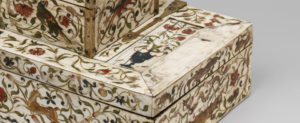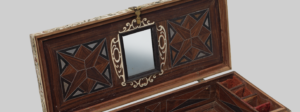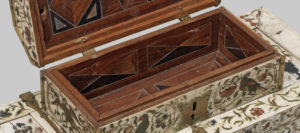Controversial imports: ‘White gold’ and endangered woods
In 1975, ivory, rosewood, and ebony became protected natural goods in international law by the Convention on International Trade in Endangered Species of Wild Flora and Fauna (CITES). It’s unlikely that an object like this box, containing these varied and exotic materials could be created today given the CITES restrictions on trade.
Ivory

Ivory, which makes up the outer veneer of this box, has been highly valued since its first use by humans which dates back nearly 35,000 years. Ivory has often been called “white gold” and fittingly it used to be purchased by the ounce just like silver or gold.
Ivory is comprised of dentine, the same hard, calcified material found in human teeth. But unlike human teeth, the brittle enamel coating on elephant tusks usually wears off the outside of the tusk throughout the elephant’s life. Art and cultural objects use ivory because it is softer and less brittle than bone, so it can be carved, cut, or shaped without splintering.
The major elephant subspecies all have tusks with different properties; Asian elephants have the hardest ivory, and African forest elephants have ivory that is yellow or brownish. Most ivory found in Europe in the 1600s was imported from Africa, so the ivory in this box might have been from either an African bush elephant or an African forest elephant. But as ivory ages – and if it experiences changes in temperature and humidity – it cracks, splinters, changes colour, and the grain fades, which makes it difficult to tell now exactly which type of elephant the ivory originally came from.
Its high value and rarity have meant that ivory has always been closely associated with slavery and poaching. Although the trade of ivory was banned in international law in 1989, the illegal ivory trade has lived on. In 2018, an ivory ban in the UK was passed into law, which stipulates that even old objects containing ivory can no longer be purchased except by accredited museums.
Ebony

Ebony wood is used in the parquetry patterns on the inside of the box’s lids. True ebony, which grows most commonly in Madagascar and the surrounding islands, was imported to Europe by the Portuguese starting in the 16th century. Its hardness, almost-black colour, and lustrous surface made it so desirable that it was usually too expensive to use for anything but veneering. When the Dutch East India Company began importing ebony after 1602 it became more plentiful in Europe, but it was still expensive enough that it was often imitated with dyed, blackened pear wood.
Ebony is still a precious wood today. The ebony used in objects like this box comes from the heartwood, or the inner core of the tree. This is the only part of the tree that has the characteristic density and dark colour. The heartwood doesn’t begin to form until the tree has developed for many years, so ebony trees must grow for upwards of 100 years before they’ll develop enough heartwood to be useful. Heartwood forms when the inner cells die and stop conducting water or nutrients. Because materials no longer pass through this dense, ‘dead’ inner part of the tree, deposited compounds like tannins, oils, resins, and salts remain in the heartwood. These various compounds cause the characteristic black colour of the ebony heartwood. Ebony is so hard that it can dull woodworking tools.
Rosewood

Rosewood, whose name comes from the persistent flowery smell it produces, is also used in the parquetry interior of this casket. Unlike ebony, rosewood was not commonly imported to Europe until the 17th century. There are many varieties of rosewood, but most rosewood brought to Europe in the 1600s came from Brazil, making Brazil the likely origin of the rosewood in this box.
The characteristic rosewood smell is caused by the compound linalool, a naturally occurring alcohol. This compound is produced by over 200 species of plants and is used as a scent in 60-80% of perfumed personal and cleaning products. Linalool’s spicy, tropical scent can be captured through boiling rosewood tree branches or sawdust and distilling the boiled water into oil. One of the first famous products to use this oil was Chanel No. 5 starting in the 1920s. The introduction of this perfume marked the beginning of a high demand for rosewood which eventually led to huge declines in worldwide populations. Like with ivory, international law now prevents the growth of the rosewood market and restricts rosewood trade.
These materials are curious and rare today – imagine how exciting it might have been to own a single object containing all of them in the early 1600s! The exploration and subsequent shipping routes that brought ivory, ebony, and rosewood into Europe were revolutionary at the time. Materials that originated on another continent would have made this beautiful box inspire curiosity at the time of its creation, as it continues to do today. It is clear that it was made as an object of luxury to be displayed by its owner and the privileged guests who would have been invited to admire it.

